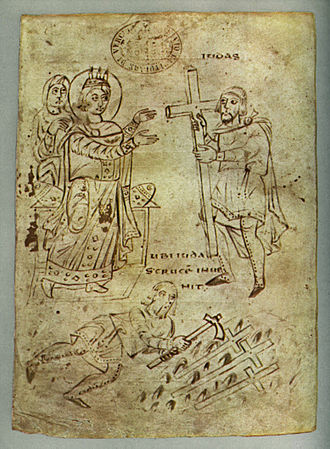St Helena finding the true cross, Italian MSS c825, Source: Wikicommons.
For those who use the traditional Benedictine Office and follow one of the monasteries that have revived this feast, I've put together the texts for both Matins and the day hours of the feast of Finding of Holy Cross arranged as for the Benedictine Office, and you can find them over at my Lectio Divina Notes Blog.
The feasts of the sign of the Cross
This feast was suppressed in the 1962 Benedictine and General Roman calendars, but is being revived in many places.
Most of the texts are the same as for the feast of the Exaltation of Holy Cross (September 14), save for the addition of alleluias because of the season.
But there are a few differences, reflecting the fact that while both celebrate the sign of the Cross (rather than the Passion per se), they celebrate two different events.
The feast of the Exaltation of Holy Cross celebrates the recovery of the true Cross in AD 629 by the Byzantine emperor Heraclius, after it had fallen into the hands of the Persian Emperor Chosroes II in the AD 614 Sasanian conquest of Jerusalem.
The feast of the finding of Holy Cross on May 3, by contrast, celebrates its initial recovery by St Helena, mother of the Emperor Constantine the Great, in 327.
The finding of Holy Cross
The Matins (Nocturn II) readings describing the events celebrated in the feast of the finding of Holy Cross read as follows:
After that famous victory which the Emperor Constantine gained over Maxentius, in the year 312, on the eve of which the banner of the Cross of the Lord had been given to him from heaven, Helen, the mother of Constantine, being warned in a dream, came to Jerusalem, in 326, to seek for the Cross. There it was her care to cause to be overthrown the marble statue of Venus, which had stood on Calvary for about one hundred and eighty years, and which had originally been put there to desecrate and destroy the memorial of the sufferings of the Lord Christ. The like work Helen did at Bethlehem, by cleansing from an image of Adonis the stable where the Saviour was born, and from an idol of Jupiter, the place where he had arisen from the dead.
When she had thus cleansed the place where the Cross had stood, Helen caused deep excavations to be made, which resulted in the discovery of three crosses, and, apart from them, the writing which had been nailed on that of the Lord. But which of the crosses had been His was unknown, and was only manifested by a miracle. Macarius, Bishop of Jerusalem, after offering solemn prayers to God, touched with each of the three a woman who was afflicted with a grievous disease. The two first had no effect, but at the touch of the third she was immediately healed.
Helen, after she had found the life-giving Cross, built over the site of the Passion a Church of extraordinary splendour, wherein she deposited part of the Cross, shut up in a silver case. Another part which she gave to her son, Constantine, was laid up in the Church of the Holy Cross of Jerusalem, which he built at Rome on the site of the Sessorian Palace.
She also gave to her son the nails with which the Most Holy Body of Jesus Christ had been pierced. Constantine established a law abolishing the punishment of crucifixion for all time coming and thenceforth what had hitherto been a hissing and a curse among men, began to be esteemed worshipful and glorious.

No comments:
Post a Comment